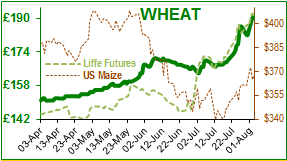There appears to be no slowing the speed of the price rise of the UK wheat futures this week! Following our report last week of a month starting at contract highs of £163/T and touching a high of £190/T, this week it peaked at £195, and closed at £191.35.
With the UK wheat market continuing to be closely linked to European markets, the focus is firmly on the drought induced crop losses to both UK spring wheat and barley. Similarly losses in yield and quality from drought have been reported in many of our wheat exporting countries such as Russia and the Baltic region. UK wheat buyers have previously put off buying wheat, convinced that the prices have been too high, and that a harvest dip is due, however the combination of yield reducing supply and tight demand, has meant that the trade has increased its short term cover. The funds are increasing their long position and projecting further gains. Sellers are hard to find, and buyers outnumber those willing to part with grain who see prices continue to rise.
Maize and barley prices, have also lifted as traders look for alternatives to try to offset the rising cost of wheat, although these commodities are not without issues due to the weather conditions.
The ruminant market is seeing increased demand for feed due to the hot dry summer affecting the availability of grazing. Haulage has become more costly, as demand is high at harvest, which in turn adds to the already inflated prices.
Global wheat stocks are falling, due to falling plantings and lower yields across the world, so the expected demand on key exporters pushes world wheat prices higher to similar levels seen in the UK and Europe.
Reports of the rising export costs, and increasing concerns about the quality of Russian wheat at the start of the week, have further supported the rally. Additionally there was more price supporting (and conflicting) news from the Ukraine that they may restrict exports of milling wheat. Initially, Bloomberg reported that a memorandum with traders was planned to limit Ukrainian grain exports during the season, which originated from a statement from their Agriculture Minister (made on social media) which caused Chicago to jump to its highest price since 2015 - September wheat jumped 6.2% in one session. However, soon after the original report, a press release for the Ukrainian Agriculture Minister stated that no talks directly limiting milling wheat exports had happened and that the traditional memorandum talks were related to forecast not strict limits. Nonetheless, these rumours were enough to push the UK Liffe May 19 feed wheat contract touch £200/T.
The soya bean trade slowed a little this week as the $ firmed on news of further worries over the escalation in the trade tension between the US and China. Washington confirmed that the administration intended to increase tariffs on $200 billion Chinese imports from 10% to 25%. US soya bean export figures show that purchases by the EU were already up before the announcement in July that the EU would increase purchases. This indicates that the market price contributed to the increase before the deal was made between the EU and US. The US has record soya stocks following the loss of exports to China.
The USDA Crop progress report reported that 70% of the soya bean crop is rated as good to excellent. However, some areas such as Kansas and Missouri are seeing crops struggle due to drought, it seems the picture is more mixed but is still likely to be above average in terms of size.
An Iceman’s last supper has changed thoughts on the mystery of his life. When discovered in 1991 Ötzi the Iceman, who perished 5,300 years ago in the Alps, was thought to be a fugitive fleeing a mob due to his location and analysis showing he had died of exposure with an arrowhead lodged in his left shoulder and deep cut to his right hand.
Researchers at the Institute for Mummy Studies in Bolzano, discovered that he not only had a full stomach at the time of death, but that its chemical composition including phytanic acid, iron, zinc, magnesium and sodium are constant with red meat and dairy products.
Having eaten 46% animal fats by weight along with some whole grain cereal and herbs this balanced meal is similar to those nowadays preparing for strenuous physical activities in harsh conditions. This suggests the iceman knew the value of the fat for this situation and had planned his expedition into the mountain rather than fleeing.
There may also be evidence that he was well ahead of his time when it came to his dance moves…..Dab!






















